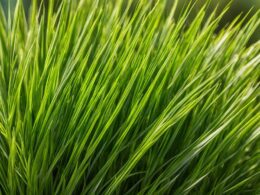Have you ever wondered how many blades of grass exist in the world? It’s a fascinating question. Unfortunately, determining the exact number is incredibly challenging due to various factors like climate, soil conditions, and the sheer vastness of grasslands. However, scientists have made estimations using different methods.
According to their calculations, the number of blades of grass in the world ranges from a mind-boggling 29*10^29 to a staggering 1200 trillion strands of hair. As you can see, the quantity of grass on Earth is immense. However, pinpointing the exact count remains elusive.
The Significance of Grass in Ecosystems and Human Life
Grass is not just a simple plant that covers the ground. It plays a crucial role in both natural ecosystems and human life, shaping the world in numerous ways.
In natural ecosystems, grasses form the foundation of vast grasslands, covering extensive areas across the globe. These grasslands provide essential sustenance for herbivores like bison, zebra, and antelope, supporting their populations and facilitating a delicate balance in the ecosystem. Grasses also have a significant impact on the planet’s climate regulation through their involvement in carbon and nitrogen cycles, effectively trapping carbon dioxide and influencing the Earth’s atmospheric composition.
In human life, the significance of grass cannot be overstated. Grasses serve as a primary food source for livestock, playing a critical role in meeting the world’s demand for meat and dairy products. From the grazing lands for cattle to the forage crops for poultry and other farm animals, grass provides the nutritional base for animal agriculture. Moreover, grasses are staples in agricultural produce, such as cereal grains like corn, wheat, and rice, which form the foundation of our diets. These crops not only feed a large portion of the global population but also support economies and livelihoods around the world.
Grasses are not limited to rural landscapes; they also have a significant impact on urban environments. In cities, grasses form the basis of green spaces and lawns, contributing to air quality by absorbing pollutants and producing oxygen. They also help regulate water runoff, preventing erosion and maintaining the health of urban ecosystems. Additionally, grassy areas provide recreational spaces for countless activities, promoting physical well-being and enhancing the urban aesthetic.
The significance of grass in both ecosystems and human life is undeniable. Its contributions to the planet’s ecosystem, its role in providing sustenance, and its impact on the landscape all highlight the remarkable value of this humble yet essential plant.
The Role of Grass in Ecosystems:
- Forms the foundation of grasslands
- Provides sustenance for herbivores
- Contributes to climate regulation through carbon and nitrogen cycles
The Significance of Grass in Human Life:
- Serves as a primary food source for livestock
- Staple food crops in agriculture
- Contributes to air and water quality in urban landscapes
- Provides recreational spaces
Estimating the Number of Grass Blades
Scientists have employed various methods to estimate the staggering number of grass blades that blanket our planet. These methods encompass satellite imaging, remote sensing, and ground-based surveys. By utilizing technology and carefully analyzing data, researchers have gleaned valuable insights into the quantity of these ubiquitous plants.
Satellite imaging has proven instrumental in obtaining a comprehensive view of grasslands across vast areas. High-resolution satellite images capture the expansive green carpets, allowing scientists to analyze patterns and calculate approximate blade densities. However, the sheer size and diversity of grasslands present challenges in obtaining precise estimations.
Remote sensing techniques have also been employed to estimate the number of grass blades. This involves using specialized sensors and equipment to collect data about vegetation cover. By measuring reflectance or emitted radiation, researchers can infer the presence and density of grass blades in different locations.
Ground-based surveys involve physically counting grass blades in specific sample areas. Researchers carefully select representative plots and use systematic counting methods to estimate the number of blades in those areas. This meticulous process provides valuable data to extrapolate estimations for larger regions.
To complement these methods, scientists have developed computer models that extrapolate data from smaller-scale studies to estimate the number of grass blades in larger areas. These models take into account variables such as soil conditions, climate patterns, and biodiversity to provide more comprehensive estimations.
The estimation of grass blades on a global scale poses significant challenges due to the vastness and complexity of grasslands. Factors such as climate change and habitat loss present additional obstacles to accurate estimations. Despite these challenges, scientists have made rough estimates to shed light on the immense quantity of grass blades in the world. However, the true count remains a captivating mystery that continues to spur further research and exploration.
How Many Different Types of Grass Are There and How Many of Them Are in Texas?
Texas is home to several of the best Texas grass types, including Bermuda, St. Augustine, and Zoysia. In fact, there are over 200 different types of grasses, and Texas boasts a wide variety due to its diverse climate and soil conditions.
Conclusion
While it is impossible to provide an exact number, the quantity of grass blades in the world is astounding. Grass plays a vital role in ecosystems, providing sustenance, contributing to climate regulation, and shaping landscapes.
Estimating the number of grass blades is a challenging task, but scientists’ efforts have yielded valuable insights into the magnitude of these plants. Through methods such as satellite imaging, remote sensing, and ground-based surveys, researchers have made estimations, although the true count remains elusive.
As we continue to explore and protect these vital ecosystems, it is important to appreciate the significance of grass in our world. Despite the challenges in estimation, the importance of grass blades in providing food, maintaining ecological balance, and creating visually appealing environments cannot be overstated.
While we may never know the exact number of grass blades that carpet our planet, their immense contribution to the wellbeing of ecosystems and human life is undeniable. Let us continue to cherish and safeguard grasslands, recognizing the irreplaceable role of grass in our natural and cultivated environments.









